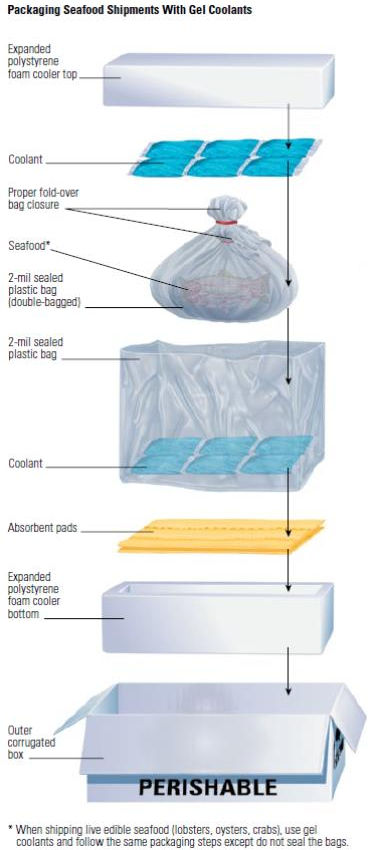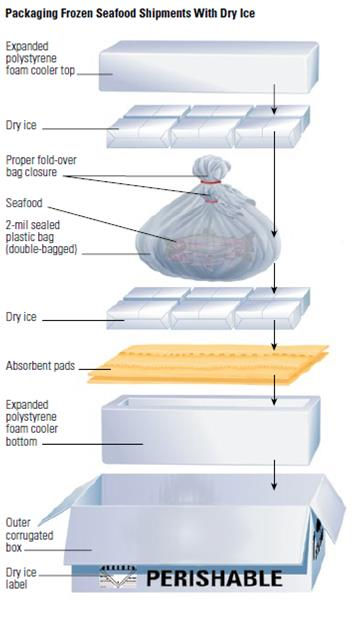
Special Handling
Seafood Items

It is the shipper's responsibility to package all perishable shipments. To maximize freshness and quality, the product must be able to withstand a minimum of 48 hours in transit until pickup, without refrigeration. The following acceptance standards comply with general regulations of all major carriers.
Packaging
-
Freeze or chill seafood thoroughly before packaging for best final destination temperature. Dry Ice will ship best to ensure proper temperature upon arrival.
-
Select durable, watertight packaging, preferably with insulation. Commercially manufactured seafood shipping boxes are preferred for shipping.

Seafood Boxes
-
Seafood shipping boxes provide easy handling, better stacking capability and allow for maximum cubic space capacity.
- Styrofoam liners maybe used inside polyethylene liners for additional insulation and protection from punctures caused by bones or fins.
-
Previously used containers are not acceptable.
-
Containers must be sealed or secured with strapping tape, or a similar material.
-
Styrofoam coolers or boxes are excepted as long as they are kept in a waterseald box.
-
Air freight containers (EO, EH or E) are not accepted for shipping seafood.
-
Gel ice packs are recommended to hold perishables at proper temperatures.
-
Wet ice is not allowed.
-
Dry ice is excellent for freezing perishables. Each container must be clearly marked with the words "DRY ICE" and the quantity of dry ice. More than 5.5 pounds requires the processing of Dangerous Goods documentation.
-
High standards of packaging on all seafood shipments must be maintained.
-
Leakage must be prevented at all times.
-
Shipments need to able to withstand the weight of stacking.
-
Manual handling.
-
Securment strap pressure.
-
Exposure to the elements when transfering cargo.
Labeling / Marking
All containers of seafood and wildlife (including shellfish) being shipped interstate must be marked according to the 1988 Lacey Act. A Fish/Wildlife Sticker may be used by the shipper to provide required information. The following six items to be prominently displayed on each shipment:
-
Name and address of shipper and consignee, or passenger.
-
24-hour phone number of the consignee or passenger.
-
Commodity note as Fish or Wildlife.
-
Specifies species name: such as King Salmon, Moose, Caribou, Silver Salmon.
-
Number of each species or the weight of each type species.
-
Each container must be marked Live, Fresh or Frozen.
Weight Limitations
-
ULDs on palletized aircraft, King Salmon, Halibut, Tuna and other large-bodied seafood shall be allowed in boxes up to 150 lbs. These can only be routed between the state of Alaska and Seattle.
How to Package Seafood




